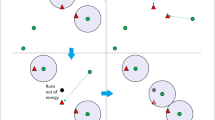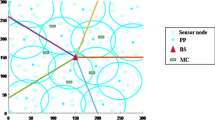Abstract
Mobile elements have shown the advantages in wireless sensor networks not only in data collection and transmission but also in the field of region coverage. The mobile sensor nodes (MSNs) whose mobility is controlled, visits the predetermined locations and collects the environmental information as per the procedure called MSNs traversal algorithms. The major performance bottleneck in MSNs is the energy source which is impractical to replace after the deployment. In random deployment, single or a group of MSNs may fall at the same location or at different locations, whose starting positions of traversal and traversal paths may differ from the preplanned. This work formulates the problem of scheduling the MSNs in distributed manner so that the entire region is covered without coverage holes with minimum energy depletion. Finally, some computationally practical algorithms for multiple MSNs with fault and non-fault tolerant support are presented and their performances compared.







Similar content being viewed by others
References
Ammari, H. M., & Das, S. K. (2008). Integrated coverage and connectivity in wireless sensor networks: A two-dimensional percolation problem. IEEE Transactions on Computers, 57(10), 1423–1434.
An Enginnering Handbook. (1977). DC motors, speed controls, servo systems. Oxford: Pergamon Press.
Bai, X., Yun, Z., Xuan, D., Lai, T. H., & Jia, W. (2010). Optimal patterns for four-connectivity and full coverage in wireless sensor networks. IEEE Transactions on Mobile Computing, 9(3), 435–448. https://doi.org/10.1109/TMC.2009.143.
Cardei, M., Thai, M. T., Li, Y., & Wu, W. (2005). Energy-efficient target coverage in wireless sensor networks. Proceedings IEEE 24th Annual Joint Conference of the IEEE Computer and Communications Societies, 3, 1976–1984. https://doi.org/10.1109/INFCOM.2005.1498475.
Dong, Q., & Dargie, W. (2013). A survey on mobility and mobility-aware MAC protocols in wireless sensor networks. IEEE Communications Surveys Tutorials, 15(1), 88–100. https://doi.org/10.1109/SURV.2012.013012.00051.
D’Souza, R. J., & Santoshi, G. (2012). Optimal 2-coverage by heterogeneous mobile sensor nodes using triangular scheme. In Elsevier procedia technology, 2nd international conference on computer, communication, control and information technology (C3IT-2012) on February 25–26 (vol. 4, pp. 187–195). https://doi.org/10.1016/j.protcy.2012.05.028. http://www.sciencedirect.com/science/article/pii/S2212.
D’Souza, R. J., & Santoshi, G. (2014). Dynamic coverage by hemegeneous mobile sensor nodes using tri-hexagonal scheme. In Emerging research in electronics, computer science and technology. Springer lecture notes in electrical engineering. https://doi.org/10.1007/978-81-322-1157-0-93.
Fu, X., Xu, Z., Peng, Q., You, J., Fu, L., Wang, X., & Lu, S. (2017). Conmap: A novel framework for optimizing multicast energy in delay-constrained mobile wireless networks. In Proceedings of the 18th ACM international symposium on mobile Ad hoc networking and computing, Mobihoc ’17 (pp. 2:1–2:10). New York, NY: ACM. https://doi.org/10.1145/3084041.3084047.
Fu, L., Wang, X., & Kumar, P. R. (2017). Are we connected? Optimal determination of source—Destination connectivity in random networks. IEEE/ACM Transactions on Networking, 25(2), 751–764. https://doi.org/10.1109/TNET.2016.2604278.
Gong, H., Fu, L., Fu, X., Zhao, L., Wang, K., & Wang, X. (2017). Distributed multicast tree construction in wireless sensor networks. IEEE Transactions on Information Theory, 63(1), 280–296. https://doi.org/10.1109/TIT.2016.2623317.
He, S., Chen, J., Sun, Y., Yau, D., & Yip, N. K. (2010). On optimal information capture by energy-constrained mobile sensors. IEEE Transactions on Vehicular Technology, 59(5), 2472–2484. https://doi.org/10.1109/TVT.2010.2044592.
Khan, A., Qiao, C., & Tripathi, S. K. (2007). Mobile traversal schemes based on triangulation coverage. Mobile Networks and Applications, 12(5), 422–437. https://doi.org/10.1007/s11036-008-0044-6.
Kreshner, R. (1939). The number of cirlces covering a set. American Journal of Mathematics, 61(3), 665–671.
Mikhaylov, K., & Tervonen, J. (2013). Energy Consumption of the mobile wireless sensor network’s node with controlled mobility. In Advanced information networking and applications workshops (WAINA), 2013 27th international conference (pp. 1582–1587). https://doi.org/10.1109/WAINA.2013.86.
Purohit, G. N., Verma, S., & Sharma, M. (2010). Hexagonal coverage by mobile sensor nodes. International Journal of Computers and Network Security, 2(4), 41–44.
Rowe, N. C. (1997). Obtaining optimal mobile-robot paths with non-smooth anisotropic cost functions using qualitative-state reasonin. International Journal of Robotics Research, 16, 375–399.
Rowe, N., & Ross, R. (1990). Optimal grid-free path planning across arbitrarily contoured terrain with anisotropic friction and gravity effects. IEEE Transactions on Robotics and Automation, 6(5), 540–553. https://doi.org/10.1109/70.62043.
Rula, A. A., & Nuttall, J. C. J. (1971). An analysis of ground mobility models (ANAMOB). Army Engineer Waterways Experiment Station Vicksburg MS. Logistics, Military Facilities and Supplies.
Santoshi, G., & D’Souza, R. J. (2013). Fault tolerant mobile sensor node traversal schemes based on hexagonal coverage. Singapore: World Scientific Journal - Communications.
Santoshi, G., & D’Souza, R. J. (2013). Optimal 1-coverage by homogeneous mobile sensor nodes using hexagonal scheme. Networking Science,. https://doi.org/10.1007/s13119-013-0027-1.
Somasundara, A. A., Ramamoorthy, A., & Srivastava, M. B. (2007). Mobile element scheduling with dynamic deadlines. IEEE Transactions on Mobile Computing, 6(4), 395–410.
Song, G., Zhou, Y., Ding, F., & Song, A. (2008). A mobile sensor network system for monitoring of unfriendly environments. Sensors, 8(11), 7259–7274. https://doi.org/10.3390/s8117259.
Song, G., Zhou, Y., Wei, Z., & Song, A. (2008). A smart node architecture for adding mobility to wireless sensor networks. Sensors and Actuators A: Physical, 147(1), 216–221. https://doi.org/10.1016/j.sna.2008.05.005.
Sun, Z., & Reif, J. (2003). On energy-minimizing paths on terrains for a mobile robot. In Robotics and automation, proceedings of IEEE international conference, ICRA ’03 (vol. 3, pp. 3782–3788). https://doi.org/10.1109/ROBOT.2003.1242177.
Wang, G., Irwin, M., Berman, P., Fu, H., & La Porta, T. (2005). Optimizing sensor movement planning for energy efficiency. In: Low power electronics and design. Proceedings of the 2005 international symposium, ISLPED ’05.
Wang, B. (2011). Coverage problems in sensor networks: A survey. ACM Computing Surveys, 43(4), 32.
Wang, G., Irwin, M. J., Fu, H., Berman, P., Zhang, W., & Porta, T. L. (2011). Optimizing sensor movement planning for energy efficiency. ACM Transactions on Sensor Networks, 7(4), 33:1–33:17. https://doi.org/10.1145/1921621.1921627.
Yu, J., Wan, S., Cheng, X., & Yu, D. (2017). Coverage contribution area based \(k\) -coverage for wireless sensor networks. IEEE Transactions on Vehicular Technology, 66(9), 8510–8523. https://doi.org/10.1109/TVT.2017.2681692.
Author information
Authors and Affiliations
Corresponding author
Rights and permissions
About this article
Cite this article
Santoshi, G. Mobile sensor nodes scheduling for bounded region coverage. Wireless Netw 25, 2157–2171 (2019). https://doi.org/10.1007/s11276-018-1804-2
Published:
Issue Date:
DOI: https://doi.org/10.1007/s11276-018-1804-2




